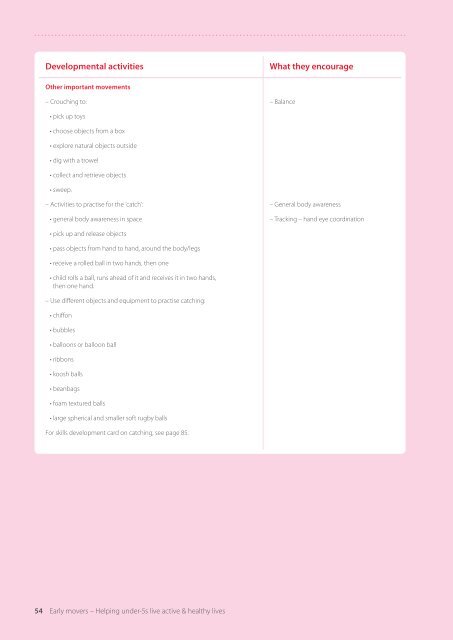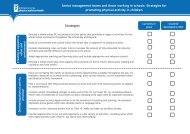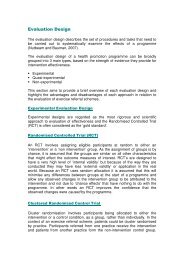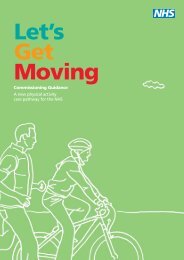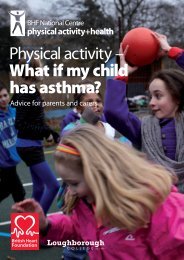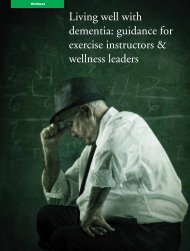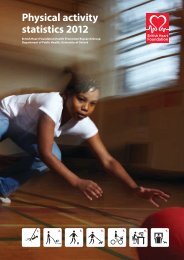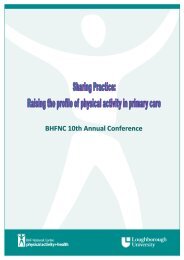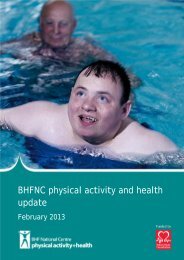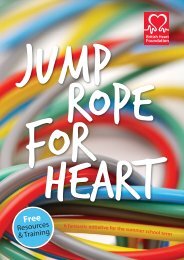5 Practical ideas for physically active play - BHF National Centre ...
5 Practical ideas for physically active play - BHF National Centre ...
5 Practical ideas for physically active play - BHF National Centre ...
- No tags were found...
You also want an ePaper? Increase the reach of your titles
YUMPU automatically turns print PDFs into web optimized ePapers that Google loves.
Developmental activitiesWhat they encourageDevelopmental activitiesWhat they encourageOther important movementsAction stories, rhythm and dance activities– Crouching to:• pick up toys• choose objects from a box• explore natural objects outside• dig with a trowel• collect and retrieve objects• sweep.– Activities to practise <strong>for</strong> the ‘catch’:• general body awareness in space• pick up and release objects• pass objects from hand to hand, around the body/legs• receive a rolled ball in two hands, then one• child rolls a ball, runs ahead of it and receives it in two hands,then one hand.– Use different objects and equipment to practise catching:• chiffon– Balance– General body awareness– Tracking – hand eye coordination– Read stories that encourage young children to carry out actions duringthe story, eg:• ‘Sometimes I like to curl up in a ball’ by Vicki Churchill and Charles Fuge• ‘The sheep gave a leap’ by Hilda Offen• ‘As quiet as a mouse’ by Hilda Offen• ‘A fox got my socks’ by Hilda Offen• ‘Fred and Ted’s treasure hunt’ by Hilda Offen• ‘Little chick’ by Amy Hest• ‘Giraffes can’t dance’ by Giles Andrease and Guy Parker-Rees• ‘Jolly Olly Octopus’ by Tony Milton and Guy Parker-Rees• ‘Fizz and Friends come out to <strong>play</strong>’ (Toddler set) www.youthsportdirect.org– Use action rhymes and nursery rhymes to practise a wide range of differentmovements. See some examples in Appendix i on page 93. More examplesof nursery rhymes and action rhymes can be downloaded from the internet.– Moving to music and sounds (bells, musical instruments). Bob up anddown to music – this is the first movement to learn when children arelearning to jump.– Body and spatial awareness– Coordination– Creativity– Sensory development• bubblesManipulative skill activities• balloons or balloon ball• ribbons• koosh balls• beanbags• foam textured balls• large spherical and smaller soft rugby ballsFor skills development card on catching, see page 85.(These aren’t necessarily physical activities, but they’re important in thedevelopment of fine motor skills, eg, doing up buttons.)– Messy <strong>play</strong> such as paint, glue and <strong>play</strong> dough.– Mark making – scribbling and drawing with thick crayons, chalk, paintingpictures, ‘painting’ with water and chalks outside.– Climbing, hanging and swinging activities – climbing frame, swings, ropes,tyre on rope.– Using tongs to pick up objects.– Posting paper through slots (start with bigger slots and decrease the widthas they progress).– Strengthen muscles in fingers, inhibit palmarreflex ready <strong>for</strong> learning to write– Develop upper body strength and strengthin fingers– Pegging activities – placing pegs in peg board.– Sensory activities – sand, clay, <strong>play</strong> dough, cornflower, water, pasta,lentils etc.– Sensory development54 Early movers – Helping under-5s live <strong>active</strong> & healthy livesSection 5 – <strong>Practical</strong> <strong>ideas</strong> <strong>for</strong> <strong>physically</strong> <strong>active</strong> <strong>play</strong> 55


